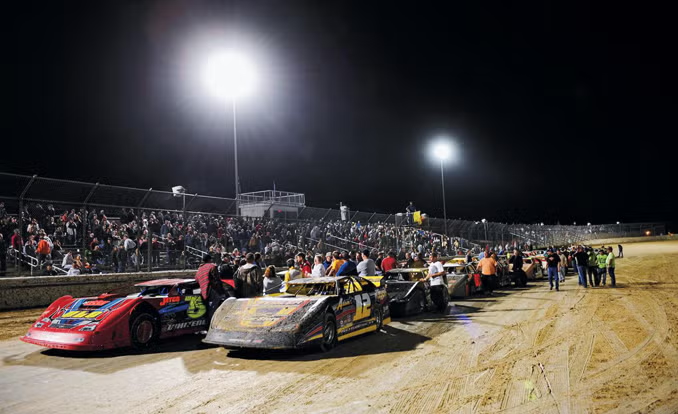
Small-town tracks are on the skids, but folks with dreams are not.
By Steven Cole Smith (source: https://www.caranddriver.com/features/a15147869/so-you-want-to-own-a-racetrack-feature)
It’s race night at Ocala Speedway in Florida, and the odor of exhaust and rubber mix with the smell of boiled peanuts and beer and cotton candy and grilling hamburgers. The stands, capacity 3500, are filling.
The little racetrack has been here for a long time. There are grandparents in the stands who first came as children. Friday night without Ocala Speedway? Hard to imagine, but it almost happened. And it has already happened in so many other towns.
“There was a time when, if you could talk the county commission into letting you carve out a racetrack on your property, you were instantly rich,” says Rich Pratt, 38, a third-generation race-car driver who lives just up the road. “Those days are over.”
Ocala’s owner, Mike Peters, stands at the entrance to the pits, wearing his aviator Ray-Bans. Peters, 39, is a jet pilot who flew Boeing 737s for an airline, but he quit to buy the speedway and run it. He admits he really doesn’t know what he was thinking when he and his fiancée, Angie Clifton, a 41-year-old vice-president of a bank, bought the racetrack at the end of 2005.
But he knows what he was thinking a year later: We made a mistake.
Ocala Speedway opened in 1952. It is just north of the town of some 50,000 that bears its name and about 35 miles south of Gainesville. It’s the oldest stock-car track in Florida—seven years older than Daytona’s superspeedway. There have been drivers, now famous, who used Ocala Speedway as a step up the ladder—NASCAR Sprint Cup driver David Reutimann was a regular until just a few years ago—but it’s the drivers you’ve never heard of, and likely never will, that keep people like Peters and Clifton in business.
Sometimes. In the past decade, Florida has lost tracks in or near Miami, St. Petersburg, Jacksonville, Orlando, St. Augustine, Lakeland, and Okeechobee, and no tracks have been built to replace them. Hialeah Speedway had been around for 51 years when it was razed in 2005 to make way for a mall parking lot, and that meant Miami-area residents who wanted to see short-track racing were faced with a two-hour drive to the next-closest surviving tracks in Clewiston or Punta Gorda. Hialeah taught NASCAR drivers Bobby and Donnie Allison how to race. Where will future stars learn?
Peters and Clifton began coming to Ocala Speedway as fans. One day Clifton saw an old Chevrolet Monte Carlo by the side of the road. For sale: $450. She bought it as a birthday gift for Peters, and they spent the next two months in his garage, turning it into a race car. “Just the two of us,” she says, “working every night on it.” The next year, he drove it to the championship in the street-stock class.
At the end of the 2005 season, word began circulating that the failing speedway would likely close if new owners couldn’t be found. “So we bought it,” Clifton says. “We thought owning a racetrack would be fun.” Especially one with history. Ocala Speedway started as a quarter-mile dirt track called Zuber Speedway, named after the community where it is located. In 1952, NASCAR was just gaining traction, and Florida was a hot spot for racing. Zuber Speedway had also been known as Lightning Speedway and Marion County Speedway before becoming Ocala Speedway. The dirt surface was expanded to three-eighths of a mile in 1964, and in 1995, it was paved with asphalt.
Ocala Speedway is a weird, egg-shaped oval that is wide and generous in Turns One and Two and tightens up like a noose in Turns Three and Four, leaving inexperienced drivers headed straight for the wall. Ocala is despised by drivers who have never figured it out, loved by those who have. During the track’s very first race in 1952, a driver flipped his midget car over the fence and landed on a sawed-off pole. He did not live to tell. The last fatality came in 2003, when Leo “Mac” McCullough wheeled his late-model car into Turn Four, bumped another car, darted through the infield, and ran head-on into the Turn One wall, throttle wide open. The impact shook the flag stand, and parts of the car’s suspension were imbedded so deeply into the steel boilerplate wall that they had to be jerked out with a wrecker. McCullough, paralyzed, clung to life for a few months, and then succumbed.

Ocala Speedway Archives ©2025 All rights reserved
